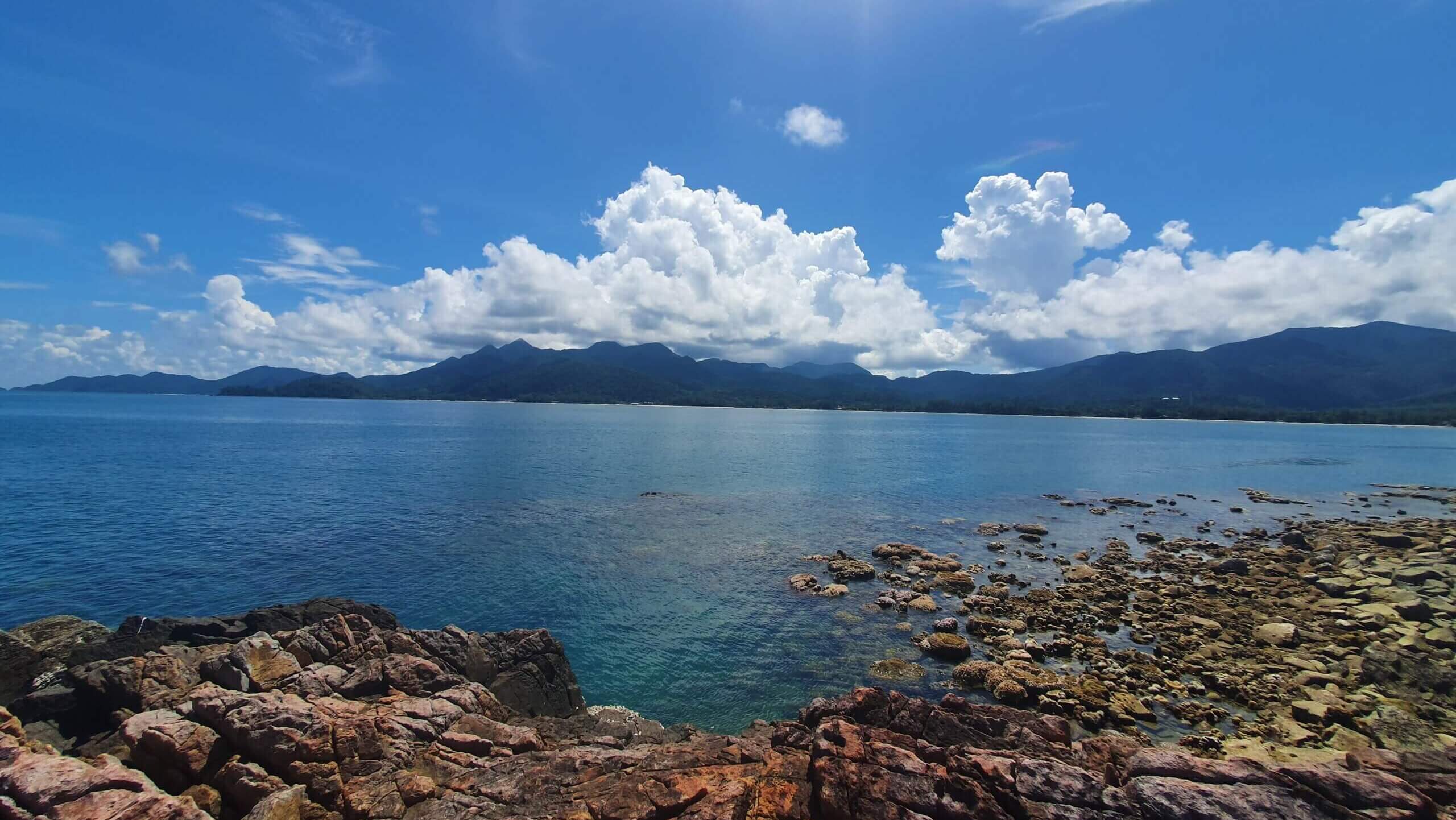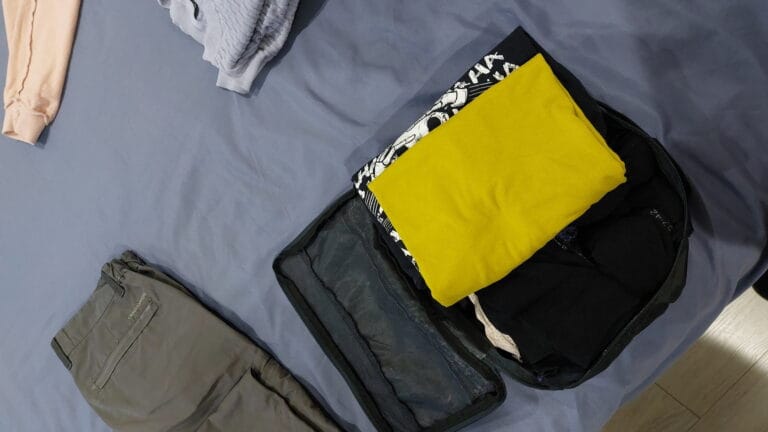Going long-term travelling? How exciting! Go to our Instagram now and DM us where you are off to, because we wanna know! (yes, we are nosy 😆)
After that though, read this post. Cause there is A LOT to do before you can sit back on a plane, with a nice glass of wine and binge your favourite TV show.
The good news?
We went through the process of planning long-term travel and now are here to help YOU on your journey.
This post may contain affiliate links. For more information, please read our Disclaimer.

Here’s a little bit about our journey, if you are new here! If you know us, feel free to skip this part.
After leaving our old life in Scotland in March 2022 (it rains too much there), we travelled full-time for almost 2 years. Sounds fancy, doesn’t it? Well, it was. If you think that carrying overpacked backpacks in 45°C heat around streets that aren’t even on Google Maps is fancy. And that’s just 1% of all the fun we had! 😆
During the 2 years we volunteered in Italy and Bulgaria (free travel while learning new skills, anyone?), explored other amazing European countries and backpacked Southeast Asia. Btw, even our secret wedding was more of an expedition than a wedding. 😅
And, of course, we researched and planned everything ourselves, because you gotta keep the budget low, right? If you are like us, you’ve come to the right place, because we want to share all the useful travel tips and info with you!
Excited? Good. Let’s get into it so you can go on your own epic adventures too!
Spreadsheets are sexy
First, a little tip.
When we were planning our long-term travel? We had spreadsheets for everything. Like literally everything. So we won’t cover it all here.
But.
We are going to tell you more about the 8 things you can’t forget to do when planning long-term travel.
And once you are finished with this post and want more tips on travelling long-term?
Don’t worry, we’ve got loads more – just head to our travel tips kingdom.
So now, pull up a spreadsheet and join the madness, if you want.
Do you have that spreadsheet? The one that has your mammoth to-do list on it? That is equally terrifying and exciting and you kinda don’t believe you will at some point actually tick all those tasks off of it?
Good.
Let’s get started.
Here are the 8 things you need to do before you set off on your long-term travel adventure:
Task no. 1: Create a packing list that doesn’t suck
Do you know how when we went full-time travelling, we researched 20 different travel blogs and their packing lists to create one monster of a list?
It was a great idea, because we felt very prepared and knowledgeable. We knew we researched enough to have chosen all the good stuff, made all the right decisions (because which filtration water bottle is the right one? And which rain jacket *actually* works? And what on earth are packing cubes??).
But it was also a bad idea because we totally overpacked. Those 3 things we wouldn’t travel with again? They are just the tip of the iceberg.
And then there still were things we had to buy. Like a body lotion, because if your skin is dry now, just wait what it will be like when it’s constantly covered in sea salt, sand or getting blasted by different climates. Ah the joys of long-term travel!
We’ve discovered lots more hacks along the way too, like these 3 weird things we now take travelling. (Don’t tell anyone.)
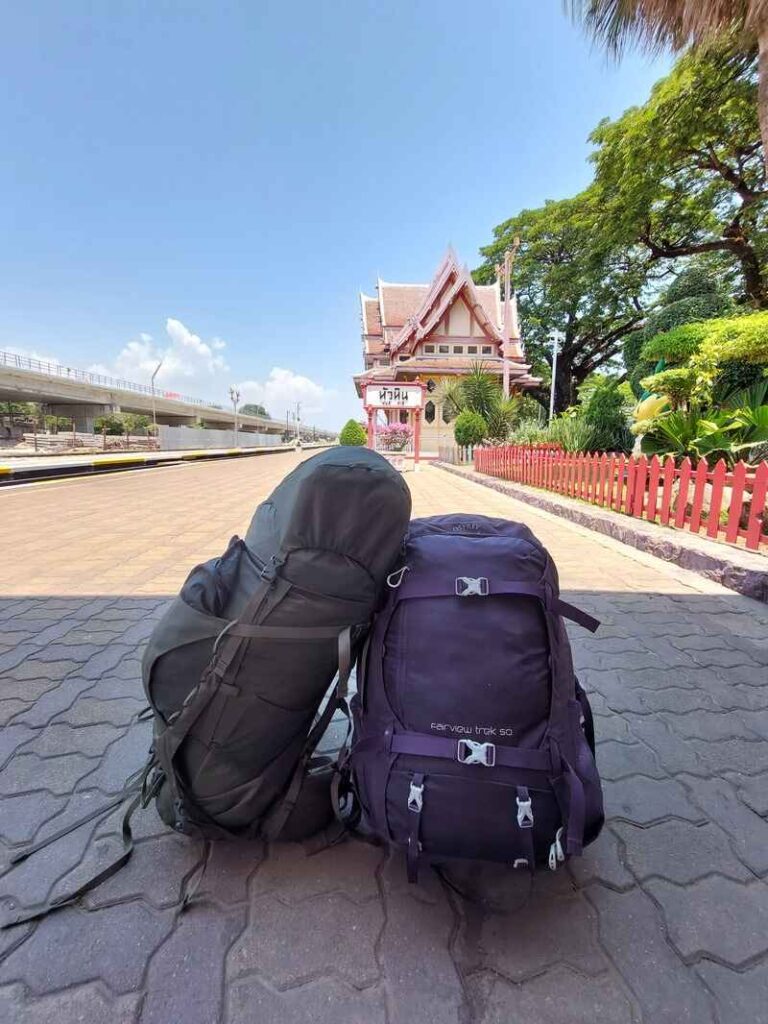
Creating a packing list
So what are we trying to say here?
Basically, when creating the packing list for your long-term travel, do this:
- Research well to see what other people packed
- But make sure you understand WHY they packed those things. Don’t just take stuff because someone else did
- Create a ginormous list with all the things that could be useful and the things you would love to take
- And then cut that list down to one-third of it. Or less
- Rethink every single item on your list. Is it really necessary?
- Lastly, put all your things into your backpack and then WALK with it for a prolonged period of time
- Did that go well? Okay, now imagine doing the same but while: tired/hungry/scared/done/sweaty/hot/freezing cold/ill/running, or a combination of any of these. Because most, if not all of that, will happen at some point on your travels (you’ve been warned)
- If you are happy with what you packed and you can carry it around, congratulations. You are good to go. If not, return back to the discarding process as described above
The golden rule of packing
This rule applies to all trips but it’s even more important for long-term travel.
The rule is: Cut down what you plan to pack. And after you’ve done that, cut down some more.
Because once you are lugging your luggage around (presumably a backpack) every day for many months, you will realise that every gram really does count.
So choose well.
And if you still need convincing as to why you should start packing light (not just for long-term travel), read this post. It not only tells you about all the benefits of packing light, but also gives you tips on HOW to pack light, even if you are known for being a chronic overpacker.

Task no. 2: Redirect your mail
Who will be taking care of your mail as you explore the world? Are you going to use a paid service or will it be one of your friends or relatives?
Some things to think about here:
- If leaving a friend or a relative in charge, pick someone who you can trust and who is reliable
- Make sure they have the relevant permissions to receive your mail
- Agree on a process with them for notifying you about anything you receive by post
- If using a paid service, remember to include this in your monthly expense calculations
3 bonus tips
Bonus tip 1: Try and go paperless everywhere you can. Is your bank still sending you statements by post, but you can change it to an email? Do so. And then see if you can do this for everything else you get as physical mail. The less physical mail you have to deal with during your long-term travel, the better.
Bonus tip 2: If you are giving up your place of residence, make sure you update your address everywhere. Create a list of everyone you have to notify and do so early on in your planning process. That way you can keep adding to it as the weeks pass and you are less likely to forget to let someone know.
Bonus tip 3: Keep the list of everyone you notified about the change of address as a Google Doc, so you can access it in the future. We did this the first time we moved and just kept it updated. Then, when you are moving again, or going long-term travelling or even changing a name after a wedding, you already have a list of everyone you need to notify, ready to go.
Task no. 3: Start selling your things early on
Here’s the deal. You’ve got a lot of stuff. Unless you are a true minimalist or you live in a van, you have a lot of stuff.
The problem is, no one ever thinks that.
Even when people think they have a lot of clothes, for example, they don’t realise that the other stuff adds up to a LOT too.
If you don’t believe us, just wait when you are packing your place up and see the amount of boxes. DM us then.
Now, if you want to get rid of your possessions in an ethical and ecological way, you might consider donating or selling. It might also help you raise funds for your long-term travel, so it’s a win-win approach.
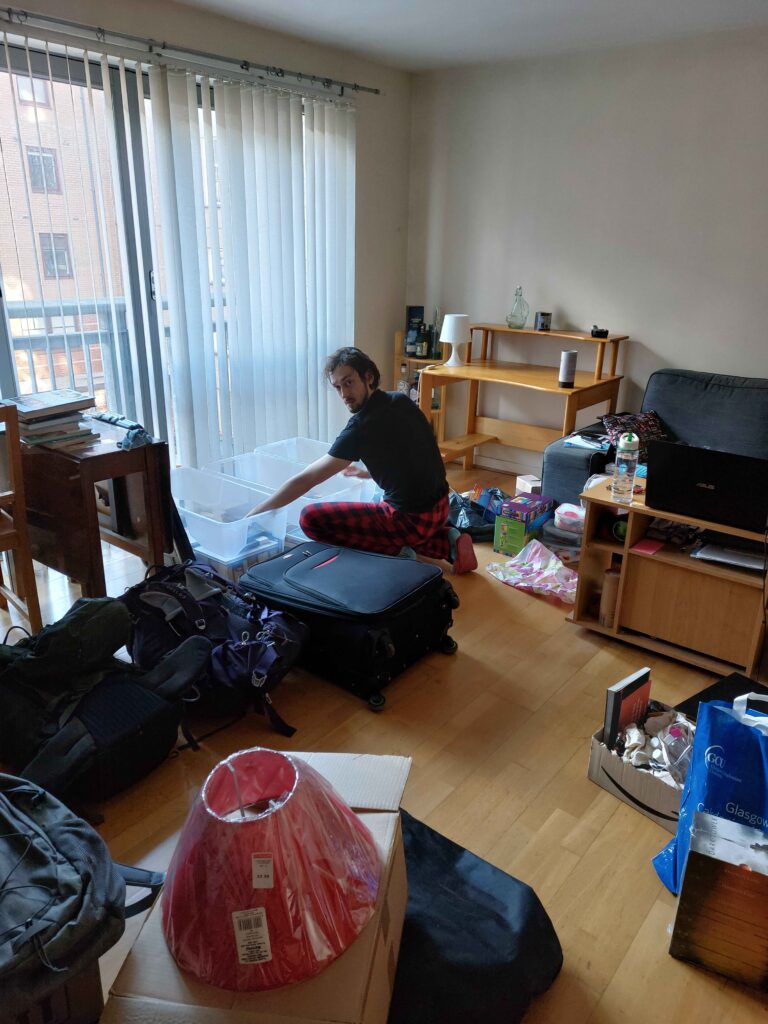
Best advice you’ll get today
Our advice?
Start the process early on.
There are two reasons:
- If you are emotionally attached to your things, it gives you time to part with them. (Although, maybe you are the kind of person who’d rather just rip off the bandaid and move on. In that case, maybe select one day when you’ll do it all and just power through)
- You won’t be pressured to try and sell everything in a few days. Or deal with running to the post office to send the orders, or, the horror of all horrors, deal with people coming over to pick their orders up while you are also packing your house up, finishing up in your job and trying to get organised to leave in 4 days.
We started mentally sorting through our things months before we left the country for our long-term travel adventure, just to have an idea of what we were going to do with each item.
We didn’t have a lot of stuff but it was still a LOT of work.
Tip on organising your stuff
Here are the different categories you might consider when sorting your things out:
- Donating – we donated books to second-hand bookshops and gave clothes away to charity shops
- Free-to-take box – we set up a “take-what-you-want” box downstairs in our building with things that were useful, but not valuable enough to sell (e.g. blank envelopes or post-it notes)
- Selling – we sold things online, on platforms like ebay, Gumtree or Craigslist
- Recycling – we dropped damaged and old clothes off in the stores that collect these (e.g. H&M or John Lewis)
- Storing – this was the pile we tried to keep the smallest – we packaged up the rest for storing
Let’s never do it again.
Task no. 4: Store your things properly
Now, speaking of storing your precious things. You have to do this right, especially if you are leaving for a long-term travel adventure and you will be gone for months or years.
As you might expect, we did a lot of research prior to packing our life up into boxes and storing it away. Would anyone really expect us to store our precious books, mementos and board games without first checking how to keep them safe? 😲
Everything depends on your situation – are you storing in a paid storage facility or in someone’s house? How long are you going away for? Does the house have problems with pests? Mould? Humidity? Any other horrible things you have to keep your stuff safe from?
All of these are things you should be thinking about prior to deciding where and how to store your possessions as you get ready for your long-term travel adventure.
Tips on storing your precious possessions
While we can’t answer these questions for you, we can tell you some tips we discovered:
- Storing in plastic boxes is the way to go. Paper boxes are a no-no; only use them for moving.
- Make sure to wash everything before putting it away. Okay, don’t go washing your university degree, but everything else? Make sure it’s clean.
- Organise things. Don’t put your birth certificate into a box with a frying pan and your prom dress. That might be an exaggeration, but basically don’t mix and match for the sake of saving space, if it doesn’t make sense. Keep things from the same category together.
- Make a list. Like a good one. Either write down what you are storing or take pictures. You think you will remember what you left behind. But after a year or two you won’t. And if you end up storing things in multiple locations like we are? We are forever on a treasure hunt with our families, trying to locate items we forgot where we stored (sorry guys for sending you on Sherlock Holmes adventures all the time!).
- Speaking of lists, label the boxes. We didn’t list every single item that is in each box, just the categories (e.g. “winter clothes”, “socks and skirts”, “books, games and memorabilia”).
Bonus tip
Get dryer sheets. This is one of our favourite hacks for long-term travel.
In case you don’t know, dryer sheets help reduce static and make your laundry smell nicer. They also absorb moisture, making them perfect for storing things.
Buy a box of dryer sheets and add a few sheets into every box you are storing away (decide the number of sheets depending on the size of the box). They will help keep moisture away and also make your clothes (and other things) smell nicer.
We came back to get some things from our boxes after more than a year of storing them, and you could still smell the nice scent from the dryer sheets!
Note: make sure you buy dryer sheets and not colour catcher sheets as they are often next to each other in the shop. Alternatively, you can get them on Amazon, which might work out cheaper for you, if you are storing many things and need a multipack of dryer sheets.

Task no. 5: Get all your checkups done. Ugh.
This is one of the least enjoyable things to do in the planning stage of your travels. But trust us, you will be grateful you’ve done it once you are on the road for a long time.
Joy no. 1: Checkups
No, medical care abroad is not as awful as many expect. At least in most places. But it’s better to set off on your long-term travel knowing that you are okay, at least when it comes to the basics.
It’s simple – go see all the doctors you need before you go travelling. And start the process early so you can get the appointments in time – you don’t want to be sitting in your dentist’s chair the day before your big flight.
Here are some checkups you might consider:
- Dentist
- Eye checkup
- Any chronic illness checkup (such as asthma)
- Cervical screening
Joy no. 2: Medication
Another boring but important thing to consider? Getting your medication in order.
Some questions to think about:
- What medication are you currently taking?
- Will you be taking it during your long-term travel?
- Can you get the medication abroad?
- How much will it cost you there?
- Is it available over the counter?
- If you want to travel with it from home, how much do you need so it lasts you for the duration of your long-term travel?
- Can you get prescribed such a large amount?
- Can you travel with such a large amount? (you don’t want to be stopped at an airport as a drug trafficking suspect) (though it might make a fun story. Depends on the outcome)
Lots and lots of boring questions, as we said.
Speak to your nurse/doctor about the different options. They can, for example, issue you with an official letter that you can show to the authorities, should your medication be questioned at an airport or a border crossing.
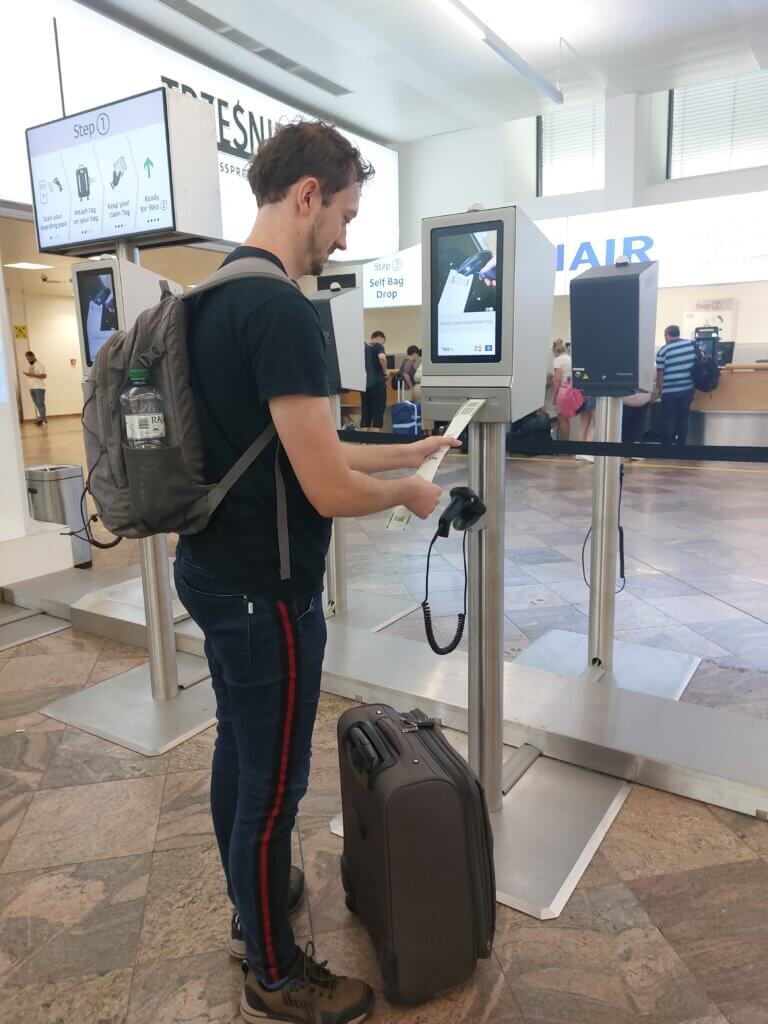
Task no. 6: Create a family group chat
If you already have a family group chat, congratulations. You either have great family relationships or are in need of therapy (don’t ask which group we belong to. The involuntary eye twitches speak for themselves).
If you don’t have one though, set it up. Go with WhatsApp as it seems like the easiest and the least overwhelming one for even the older generations.
Why is this important
Why do you need a group chat?
Once you start travelling, EVERYONE and their cat will wanna know about your journey. There will be the constant “Where are you now?” and “Where are you heading next?” questions. And they will wanna see pictures. And you know what? You will have a lot of pictures to show.
Now, we are not saying you won’t have the time or energy to reply to everyone individually. But you won’t. So do yourself a favour and start the group chat.
Then all you have to do is keep one chat updated and, hopefully, everyone will get answers to their questions (this is not guaranteed as we know that many family members are not that great at reading their messages).
This actually applies to friends too. You can create a group chat even if all your friends don’t know each other. You don’t have to talk in the chat about anything, you can just use it as a place where you send photos, especially if not all your friends are on Instagram/TikTok etc.
Tip no. 7: Find an awesome travel journal
Depending on where you live and what kind of person you are, this will either be pretty easy, or pretty hard.
Travel journaling. It’s a topic that gets, surprisingly, discussed a lot by travellers, especially when it comes to long-term travel.
There are travellers who swear by actual, physical journals.
And then there are the ones who keep their journals in a digital form, because packing light is the only way to go, especially for long-term travel.
Each has its pros and cons and, you might have guessed it, we will advise you to research this before deciding.
After lugging around 4 heavy, hardcover journals, we are now team digital.
BUT.
Travel journal advice no. 1
There is one exception.
Your very first travel journal.
Even if you wanna go digital. Make that very first one physical.
Give it a go. One day you will be happy when you can actually flick through the pages and see the physical memorabilia you glued in. Plus it looks million times cooler, writing into an actual book, than just typing away on your phone or a laptop.
That’s tip no. 1 when it comes to travel journals – get one physical one.
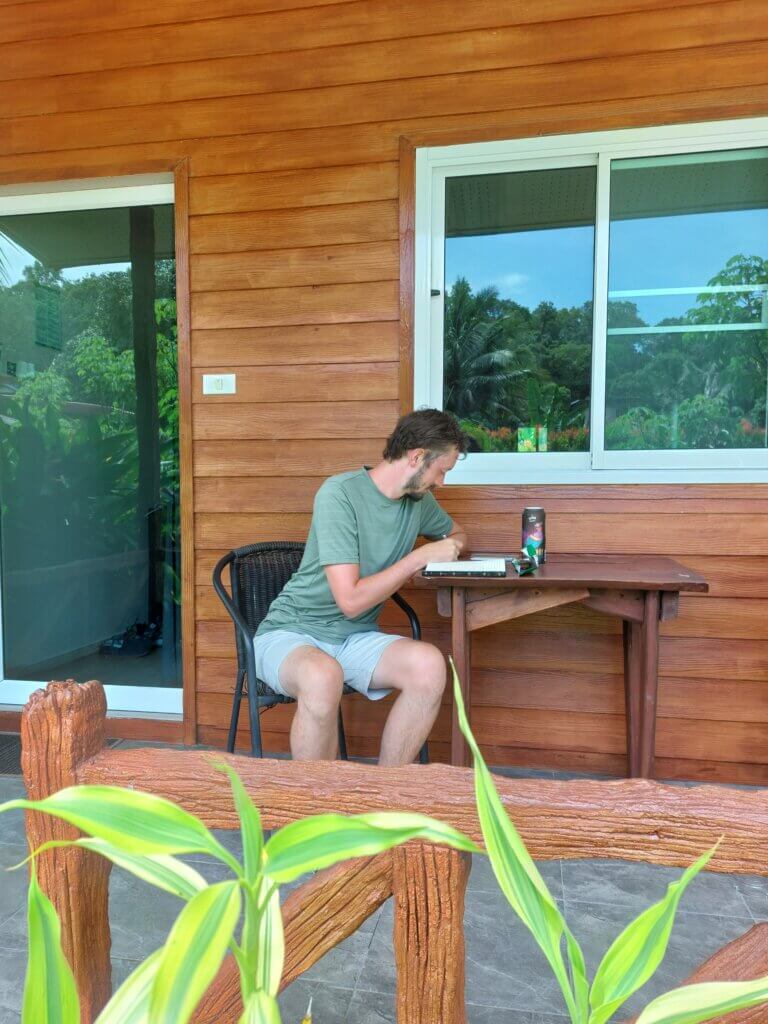
Travel journal advice no. 2
Tip no. 2 is finding a journal that is special. Don’t just get some boring, generic black-cover notepad (Unless that’s your aesthetic).
Find something special. Something that speaks to you, that will match your excitement for this journey.
If long-term travel has been your dream and a goal for many years and you finally make it happen, you should record it somewhere pretty.
For our first journals, Mirka got a simple, but luxurious, made-in-Italy journal (funnily enough, the very first country we travelled to on our full-time backpacking journey was Italy, which we didn’t know when we bought it).
Daniel got an Asia-themed journal with an inner pocket where he could keep any mementos (yes, we did go to Asia after Italy, again an unplanned decision. Was this all signs trying to lead us on our long-term travel?).
Journal hunting is one of the most fun activities you will do before your big trip (it’s definitely more fun than rabies vaccinations). Enjoy the process. We hope you find the perfect journal for your travels!
If all of this is sounding overwhelming, don’t worry. We’d been there and it’s totally fine (and understandable, really) to feel this way. 🫶🏻 You can always book a chat with us, so we can talk through your plans together, and help you figure it all out!
Task no. 8: Get insurance
First, let’s address the whole “is travel insurance for long-term travel actually worth it” question.
Here’s how we see it:
We did a lot of research. Of course we did. We looked at 23 different travel insurance providers before deciding (yes, we are that ehm, cool). But we didn’t just look at their prices; we actually read about their coverage, policies, exceptions and all the other fun stuff, just to be more knowledgeable about insurance in general.
What we concluded is this: The best way to decide about whether to insure something is by imagining having to pay for it if something goes wrong.
This is what we mean:
Can you afford to replace your 2-year-old phone if something happens to it? Yes? Don’t insure it.
Can you afford to pay hundreds or thousands of pounds/dollars/not Monopoly money if something happens to you as you climb up a mountain and you have to be helicopter-rescued and operated on? No? Get travel insurance.
It’s as simple as that.
You won’t know what’s going to happen on your long-term travel (unless you are Phoebe from Charmed, in which case DM us with the words LOST SISTER so we can reply instantly). The only way to be prepared is by having travel insurance.
Oh and if you wanna know who we deemed worthy picked to cover us on our journey, it’s True Traveller and SafetyWing (we used each for a different part of our long-term travel adventure).
We recommend both as they are both awesome companies, with really good prices and their coverage is great. But don’t just take our word for it, check them out, do your own research and then decide.
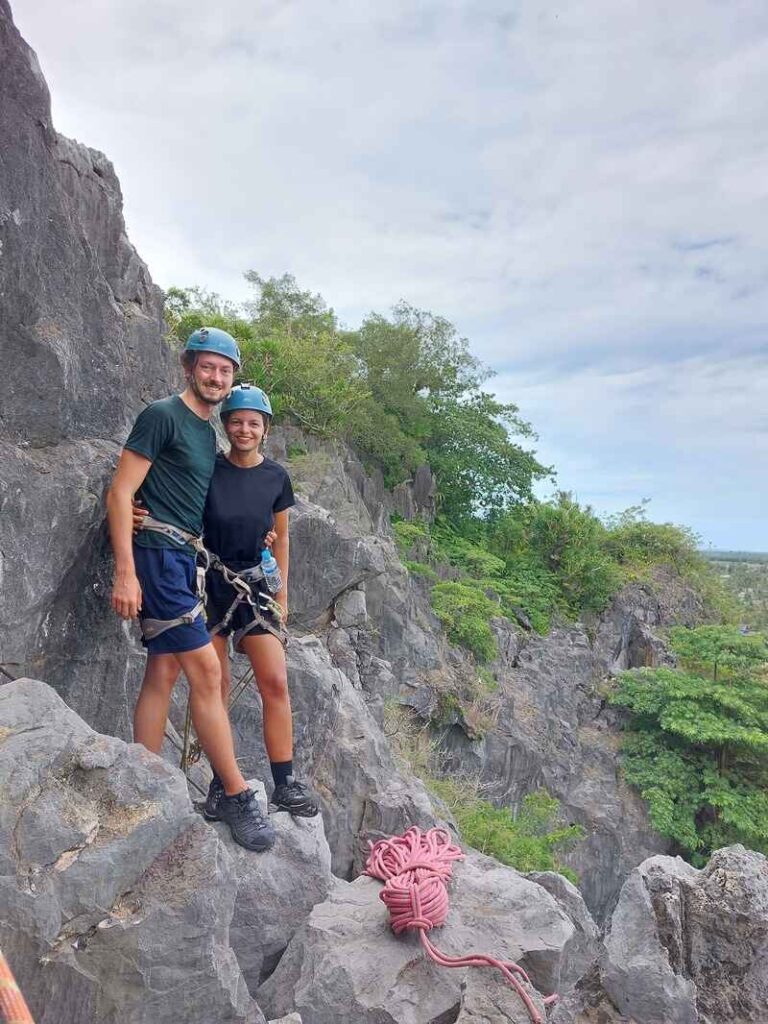
Task no. 9: Bonus!
Don’t forget about safety. We already talked about travel insurance in point 8, but there are many other things you can do to stay safe(r), such as:
- Researching and deciding on which vaccinations to get
- Making sure you pack a first-aid kit
- Adding emergency info to your phone’s lock screen
- If you are backpacking, ensuring that your backpack is safe
But the one crazy hack we recommend? It’s crazy because it’s easy, simple and we don’t see anyone else talking about it.
Create a safety document.
How? Read all about it here.
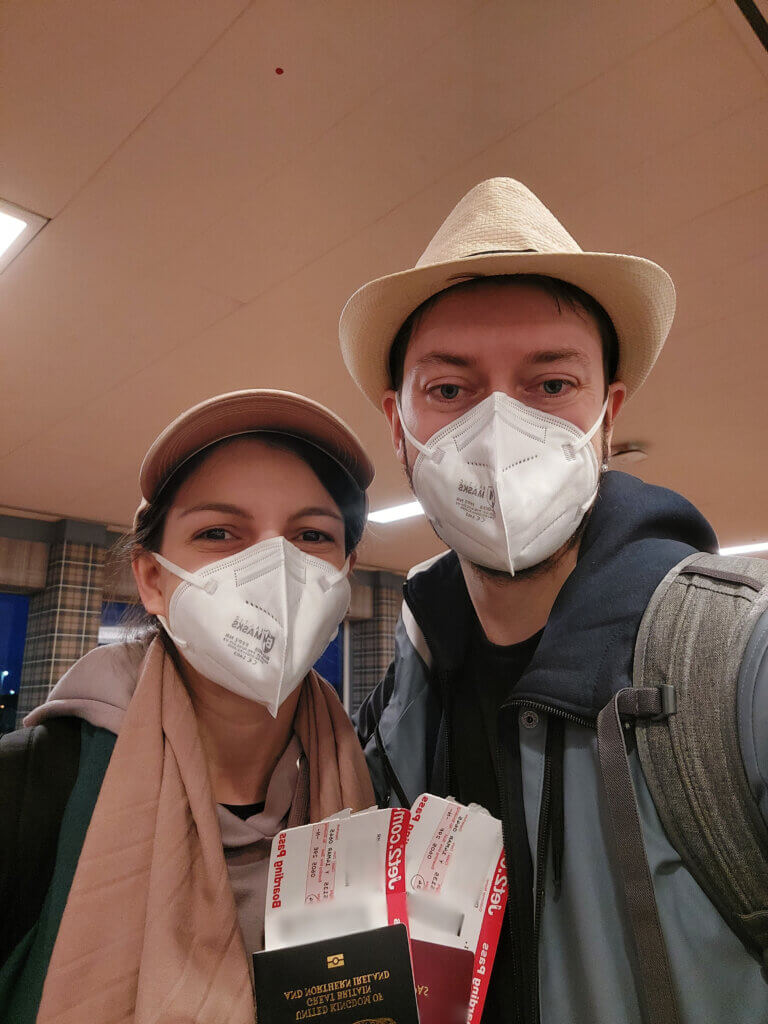
We hope this list of 9 things you should do before you set off on long-term travel was helpful. If you have any questions, drop us a comment below or DM us on our Instagram.

Hi!
We’re Mirka & Daniel — full-time travellers, professional overthinkers & bad luck magnets. We research EVERYTHING and then share all the weird travel tips with you here. Follow along to make your adventures easier! 🌴

